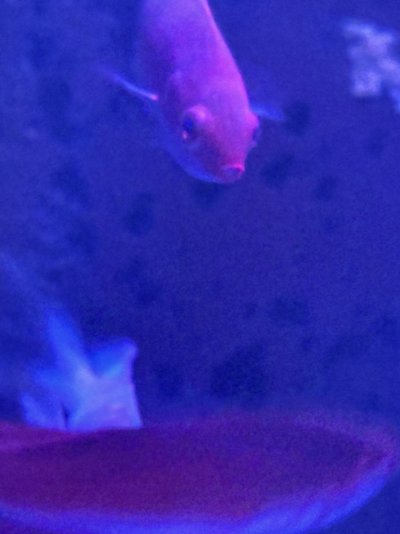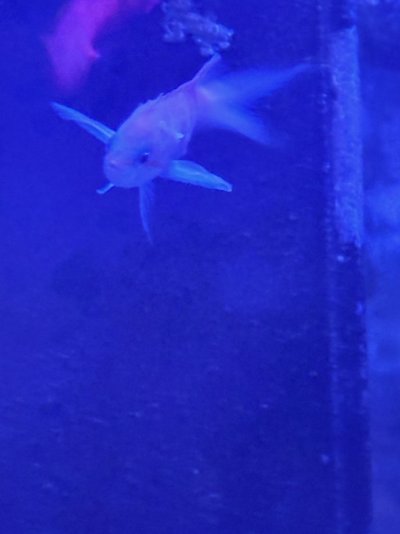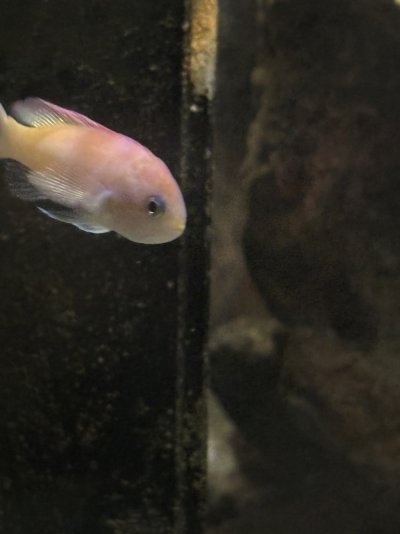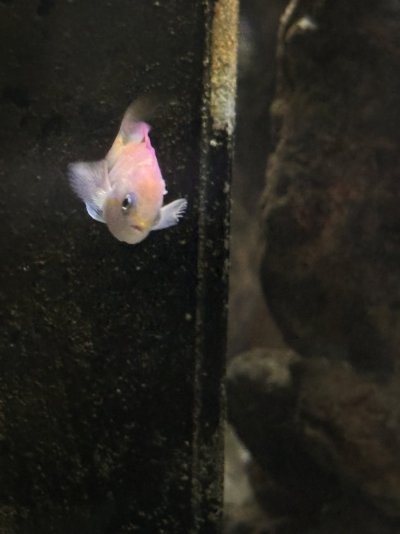Well, seems like all my fish which just arrived Monday are dying. Many came seeming to be very stressed and some with physical signs of some sort of problem. So far, 5 of them have died. This is mainly anthias and wrasse. They pretty much all seem to start having rapid respiration and develop white blemishes across their body, I am presuming it to be uronema? I also see one fish with a slightly bulging eye, hoping that should go down on its own, no cloudiness in it. Water test reveals 0 ammonia. The other fish look well for now. Curious as to what I can dose/supplement or add to the tank to reduce the stress on these fish and allow them to heal possibly. Any help is appreciated.
Navigation
Install the app
How to install the app on iOS
Follow along with the video below to see how to install our site as a web app on your home screen.
Note: This feature may not be available in some browsers.
More options
You are using an out of date browser. It may not display this or other websites correctly.
You should upgrade or use an alternative browser.
You should upgrade or use an alternative browser.
Massive Fish Death
Sounds like a very serious issue, probably disease related (but could be water quality/shipping stress). We need a lot more background information though, including video/pictures of the remaining fish. This post explains all that:

 www.reef2reef.com
www.reef2reef.com
Jay

Some Helpful Hints When Posting or Responding to Threads in the Fish Disease Treatment and Diagnosis Section
Aquarium Fish Disease Problem Solving Determining the best course of action for a problem with your aquarium can be a difficult task. Even advanced aquarists will often need to seek the help of others for complicated or unique issues. Our intent here on Reef 2 Reef is to offer expert advice...
 www.reef2reef.com
www.reef2reef.com
Jay
Thank you Jay! Your articles have been very helpful, this tank has gone through too much, and fish have always been a struggle for me
About 110 gallons I believe, I think 7 fish were added maybe?
We picked them up from the shop after they had been shipped, may have been a couple hours, I would have to ask. Now, one of the wrasses we have left looks like it has a big wound on the side, discolored and white, hoping for the best but could be Uronema based on what I’m reading and the deaths of the other anthias
Shop was holding them for us, we ordered them from online
Is there anything I can do to prevent more fish death, some medication to add, less stressful things, anything at all
I have tested some of my parameters as well as taking some photos/videos to the best of my abilities.
Nitrite: 0-0.05
Nitrate: 5-10
Ammonia: 0
PH: Unknown, test kit was old
Tank temperature: 78
Salinity: 1.025
Water Volume: About 110
Current amount of fish: 6, originally had 5 others, who died
Tank was cycling for 4 weeks, fishless, fallow prior to this with no water for a couple months after a tear down.
Filtration: protein skimmer, 2 filter socks, all in a 20 gallon? (Possibly) sump
Previous fish have passed, as stated. Some looked like they had white lines/ splotches on them. The fish were from a Local guy who was holding them after they were delivered by the online company, my dad picked them up the day of the shipment. Upon arrival, fish were in hyposalinity, acclimated, and placed in the DT. Within the same couple of days is when most of the fish perished.
The whiter looking fish is the most affected currently, as you can see with the whither marks and torn-looking scales closer to the head. It was hard to get a photo of this guy as he kept faci by me. The more red fish is a wrasse, you can see the bug-eyed of one of its eyes, does not seem to be effecting the swimming abilities or its appetite.
#fishmedic




Nitrite: 0-0.05
Nitrate: 5-10
Ammonia: 0
PH: Unknown, test kit was old
Tank temperature: 78
Salinity: 1.025
Water Volume: About 110
Current amount of fish: 6, originally had 5 others, who died
Tank was cycling for 4 weeks, fishless, fallow prior to this with no water for a couple months after a tear down.
Filtration: protein skimmer, 2 filter socks, all in a 20 gallon? (Possibly) sump
Previous fish have passed, as stated. Some looked like they had white lines/ splotches on them. The fish were from a Local guy who was holding them after they were delivered by the online company, my dad picked them up the day of the shipment. Upon arrival, fish were in hyposalinity, acclimated, and placed in the DT. Within the same couple of days is when most of the fish perished.
The whiter looking fish is the most affected currently, as you can see with the whither marks and torn-looking scales closer to the head. It was hard to get a photo of this guy as he kept faci by me. The more red fish is a wrasse, you can see the bug-eyed of one of its eyes, does not seem to be effecting the swimming abilities or its appetite.
#fishmedic




There are a few clues in your post, and their was likely multiple problems going on. The fist thing is:
"....fish were in hyposalinity, acclimated, and placed in the DT." Depending on if it was full hyposalinity, or just partial, the fish cannot be acclimated directly from that - it will either kill them outright from dehydration, or really stress them out. Going from full hypos, say a specific gravity of 1.009 to full seawater of 1.025, needs to be done gradually, over 2 or 3 days. Going from partial hypo to full seawater should be done gradually, or 24 hours.
Then, the anthias in the video and some of the symptoms you are describing sounds like Brooklynella, a protozoan parasite that is most common in clownfish, but can infect other fish. Are their any clownfish alive in the tank now? If so, then it may not have been Brook. If any clowns died, then it could well have bene that. Brook would account for some fish not dying from this.
What fish are left and are they showing any symptoms?
Jay
"....fish were in hyposalinity, acclimated, and placed in the DT." Depending on if it was full hyposalinity, or just partial, the fish cannot be acclimated directly from that - it will either kill them outright from dehydration, or really stress them out. Going from full hypos, say a specific gravity of 1.009 to full seawater of 1.025, needs to be done gradually, over 2 or 3 days. Going from partial hypo to full seawater should be done gradually, or 24 hours.
Then, the anthias in the video and some of the symptoms you are describing sounds like Brooklynella, a protozoan parasite that is most common in clownfish, but can infect other fish. Are their any clownfish alive in the tank now? If so, then it may not have been Brook. If any clowns died, then it could well have bene that. Brook would account for some fish not dying from this.
What fish are left and are they showing any symptoms?
Jay
Did you add 11 fish at one time to a newly cycled tank? From what I’ve read that seems to be the case. Plus from shipping into one tank at lfs then to your tank. These are all reasons your fish are dying. Ammonia would be my first guess then disease from all the stress.
Curious where the LFS got the shipment from. If cross country then different to overseas. Overseas could have had build up of ammonia with pH low enough that most if not all was not toxic yet upon opening the bag at the LFS fish might have suddenly been exposed to ammonia poisoning. Not an explanation for everything but might be part of it.
Based on what I know about diseases which is mostly surrounding reptiles. Existing fish might have an infection they obtained resistance to yet new fish haven’t. Not saying this is the case but often what happens when new reptiles are added to a new collection.
Obviously, new fish might have had been carrying diseases which would I believe be validated if suddenly healthy existing fish start getting sick but that’s not a guarantee as it could just be timing since it appears existing fish weren’t there long enough to possibly exclude they already had any diseases. Something I’m not well versed on but thought I’d add.
Based on what I know about diseases which is mostly surrounding reptiles. Existing fish might have an infection they obtained resistance to yet new fish haven’t. Not saying this is the case but often what happens when new reptiles are added to a new collection.
Obviously, new fish might have had been carrying diseases which would I believe be validated if suddenly healthy existing fish start getting sick but that’s not a guarantee as it could just be timing since it appears existing fish weren’t there long enough to possibly exclude they already had any diseases. Something I’m not well versed on but thought I’d add.
There was a clown, who passed on the second day possibly, I wasn’t home at the time, my dad and I both work on this tank, I was at work when he got the shipment.There are a few clues in your post, and their was likely multiple problems going on. The fist thing is:
"....fish were in hyposalinity, acclimated, and placed in the DT." Depending on if it was full hyposalinity, or just partial, the fish cannot be acclimated directly from that - it will either kill them outright from dehydration, or really stress them out. Going from full hypos, say a specific gravity of 1.009 to full seawater of 1.025, needs to be done gradually, over 2 or 3 days. Going from partial hypo to full seawater should be done gradually, or 24 hours.
Then, the anthias in the video and some of the symptoms you are describing sounds like Brooklynella, a protozoan parasite that is most common in clownfish, but can infect other fish. Are their any clownfish alive in the tank now? If so, then it may not have been Brook. If any clowns died, then it could well have bene that. Brook would account for some fish not dying from this.
What fish are left and are they showing any symptoms?
Jay
There are a few clues in your post, and their was likely multiple problems going on. The fist thing is:
"....fish were in hyposalinity, acclimated, and placed in the DT." Depending on if it was full hyposalinity, or just partial, the fish cannot be acclimated directly from that - it will either kill them outright from dehydration, or really stress them out. Going from full hypos, say a specific gravity of 1.009 to full seawater of 1.025, needs to be done gradually, over 2 or 3 days. Going from partial hypo to full seawater should be done gradually, or 24 hours.
Then, the anthias in the video and some of the symptoms you are describing sounds like Brooklynella, a protozoan parasite that is most common in clownfish, but can infect other fish. Are their any clownfish alive in the tank now? If so, then it may not have been Brook. If any clowns died, then it could well have bene that. Brook would account for some fish not dying from this.
What fish are left and are they showing any symptoms?
Jay
Current fish are just a couple Anthias and 2 wrasse. Last night, the wrasse would not come out to eat and I saw it having a large, whitish bruise on its flesh, bruise did not have any sort of distinct pattern or geometric shape to it. The Anthias pictured in the photo has some bruising as well. Most of the fish that did pass were AnthiasThere are a few clues in your post, and their was likely multiple problems going on. The fist thing is:
"....fish were in hyposalinity, acclimated, and placed in the DT." Depending on if it was full hyposalinity, or just partial, the fish cannot be acclimated directly from that - it will either kill them outright from dehydration, or really stress them out. Going from full hypos, say a specific gravity of 1.009 to full seawater of 1.025, needs to be done gradually, over 2 or 3 days. Going from partial hypo to full seawater should be done gradually, or 24 hours.
Then, the anthias in the video and some of the symptoms you are describing sounds like Brooklynella, a protozoan parasite that is most common in clownfish, but can infect other fish. Are their any clownfish alive in the tank now? If so, then it may not have been Brook. If any clowns died, then it could well have bene that. Brook would account for some fish not dying from this.
What fish are left and are they showing any symptoms?
Jay
Current fish are just a couple Anthias and 2 wrasse. Last night, the wrasse would not come out to eat and I saw it having a large, whitish bruise on its flesh, bruise did not have any sort of distinct pattern or geometric shape to it. The Anthias pictured in the photo has some bruising as well. Most of the fish that did pass were Anthias
Internal Uronema usually shows as a red or sometimes a white, linear lesion on the fish's flank, these follow the muscle myomeres and are usually angled forward, but are sometimes a bit more vertical. If the lesion is round, it may be some other issue.
That’s probably the case, I have 2 tanks running, I think i might just transfer my fish from that tank into the new one.c this hobby is expensive and I have healthy fish in my other system, I will probably wait a little while so the remaining fish in the new tank show no signs of health issues
Similar threads
- Replies
- 33
- Views
- 460
- Replies
- 6
- Views
- 82
- Replies
- 6
- Views
- 315


















